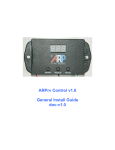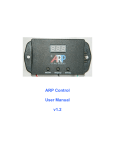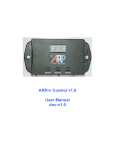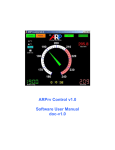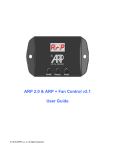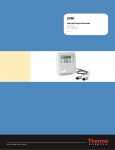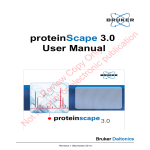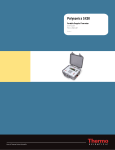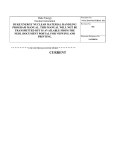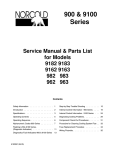Download ARP 2.0 & ARP + Fan Control v2.1 General Install Guide
Transcript
ARP 2.0 & ARP + Fan Control v2.1 General Install Guide Terms -- Conditions & Contact Information This manual is copyrighted © by ARPC L.L.C. 2013-2015. All rights are reserved. This manual may only be reproduced with permission of ARPC L.L.C.. This manual is furnished for informational use only and is subject to change without notice. This manual does not imply any commitment on the part of ARPC LLC or its business partners. ARPC L.L.C. and its business partners assume no responsibility or liability for any error or inaccuracies that may appear in this manual. By use of this document for installation and operation of the ARP Control, the user is agreeing to the ARPC L.L.C. terms and conditions found in document ARPC LLC License Agreement.pdf. Also, the end user needs to understand that the ARP Control can be turned off at any time, thereby removing the ARP Control function and reverting to the operation of the refrigerator to its previous state. Power surges can turn off the ARP Control just the same as any equipment in an RV, thus it is the operators responsibility to insure that the control is functioning. The document "ARPC LLC License Agreement.pdf" can be downloaded at web address http://www.ARPrv.com or, please send any request to e-mail address below, ARPC L.L.C. will supply information in a timely manner: [email protected] CONTENTS SAFETY .................................................................................................................................... 1 1.1 Acronyms and Abbreviations................................................................................... 1 1.2 Hazard Information.................................................................................................... 1 1.3 Work Safely ................................................................................................................ 1 1.4 Terms & Warnings Symbols ..................................................................................... 1 1.5 Operation Safety........................................................................................................ 1 1.6 ARP Control and your Refrigerator.......................................................................... 1 INTRODUCTION ....................................................................................................................... 2 2.1 What is the ARP Control? ......................................................................................... 2 GENERAL INSTALLATION...................................................................................................... 2 3.1 System Components ................................................................................................. 2 3.2 Supplies & Tools ....................................................................................................... 2 INSTALLATION - RTD.............................................................................................................. 3 4.1 Instructions for Mounting the Temperature Sensor ............................................... 3 4.2 Dometic Temperature Sensor................................................................................... 4 4.3 Norcold Temperature Sensor ................................................................................... 4 INSTALLATION - CONTROLLER ............................................................................................ 6 5.1 Location...................................................................................................................... 6 5.2 Interior Location ........................................................................................................ 6 5.3 Exterior Mounting...................................................................................................... 6 WIRING the ARP ...................................................................................................................... 7 6.1 General Information .................................................................................................. 7 6.2 Temperature Sensor Wiring....................................................................................... 7 GRAPHICAL WIRING GUIDE................................................................................................... 7 7.1 Norcold or Dometic Wiring ....................................................................................... 7 7.2 Dometic Fridge without Thermal Switch Wiring ..................................................... 7 7.3 Norcold 1200 Series Wiring ...................................................................................... 8 7.4 Manual Control Refrigerators ................................................................................... 8 v2.1 ARP + FAN CONTROL ................................................................................................... 10 8.1 Mounting Fan Sensor ............................................................................................... 10 MANUAL FRIDGE CONTROL & HIGH AMP INSTALL ......................................................... 10 9.1 Relay Overview ......................................................................................................... 10 CONCLUSION ........................................................................................................................ 11 © 2015 ARPC L.L.C. All rights reserved. ARP Control v2.x General Installation Guide DRAFT-3 04/10/2015 © 2015 ARPC L.L.C. All rights reserved. 1 SAFETY 1.1 Acronyms and Abbreviations ARP: ARP Control = ARPrv Control GND: Ground P/N: Part Number RTD: ARP Control temperature sensor; Resistance temperature detector is the type of sensor used. 1.2 Hazard Information Hazard information includes terms, symbols and instructions used in this manual or on the equipment to alert operating and service personnel to the recommended precautions in the care, use and handling of the ARP. 1.3 Work Safely There are many ways to install the ARP. Make safety your first priority! The installer’s knowledge, skill, and ability are important for safely installing the system. If you are unsure of your ability to do the installation, have a qualified installer do the work. 1.4 Terms & Warnings Symbols 1.5 Operation Safety The ARP Control and 'ARPrvSafe' infer that the use and operation of this control can add a level of safety to your absorption refrigeration system in your RV. No other RV absorption refrigerator control monitors the boiler temperature, and turns off the heat source to the refrigerator before damage may occur to the internal fluids in the refrigerator cooling unit. The ARP cannot prevent RV refrigerator failure if the manufacture built the cooling unit in a manner that would result in premature failure. It must also be emphasize that the ARP Control performs a different task than the manufactures recalls and does not replace them. 1.6 ARP Control and your Refrigerator The ARP Control is designed to work in conjunction with the manufactures safety devices that are presently on your RV refrigerator. Many of the manufactures over temperature devices have proven to turn off the refrigerator unnecessarily, rendering the refrigerator useless. Due to this common complaint, the ARP control can be turned off using the On/Off button. The end user does not need to fear a potential situation where the ARP Control keeps the refrigerator from performing its normal function. Thus, when the ARP Control is off, your refrigerator is still protected by the manufactures safety devices. It is the end user's responsibility to insure that the ARP Control is installed and functioning properly at all times, this includes the state of the control being turned on or off. DANGER Never remove or bypass any manufacture safety device when installing the ARP Control. Be aware that the ARP Control can be turned off thereby preventing its function. Know and understand you RV electrical system and its integrity for proper ARP Control use. RV electrical systems integrity are complex due to the inclusion of charging systems such as solar systems, generator, inverters and 120VAC chargers just to mention a few sources of electrical disruption that can result in disruption of ARP Control function. Always consult a certified RV repair facility and/or the manufacture of your RV if you are concerned about safety issues. __________________________________________________________________________________________ ARP Control v2.x General Installation Guide DRAFT-3 04/10/2015 © 2015 ARPC L.L.C. All rights reserved. 2 INTRODUCTION 2.1 What is the ARP Control? The ARP is a monitoring device for RV refrigerators. The ARP turns off your cooling unit heat source if refrigeration is not taking place. The ARP Control will automatically attempt to restart your refrigerator five times. RV absorption refrigerators work by boiling a fluid mixture that includes water and ammonia. The ammonia turns into a gas that rises and separates from the water mixture. The ammonia then condenses into a liquid that flows through the cooling unit tubing. During this cycle the ammonia absorbs heat thereby cooling the refrigerator. RV refrigerators are notoriously unsafe when operated off-level or in a variety of temperature and pressure conditions. If the boiler in your RV refrigerator overheats, the cooling tubes are stressed which may lead to early failure or even a rupture that leads to a fire. The ARP monitors the actual boiler temperature of your RV refrigerator to detect conditions that can be unsafe, and in turn, shut off the boiler heat source to prevent overheating. Please note that the ARP Control setup and adjustment including the Auto Tune function depend on proper function of your cooling unit at the time of the setup. The ARP Control cannot change the parameters of your cooling unit. If you have a failing, damaged, or poorly constructed cooling unit, the ARP Control cannot change this situation nor alter the physical properties within your cooling unit. Following are general installation instructions for the ARPrv Control. Please check our website (www.ARPrv.com) for specific refrigerator make and model installation information. __________________________________________________________________________________________ GENERAL INSTALLATION 3.1 System Components The ARP is not complicated. The entire ARP kit is seen in Fig. 1 as an overview for the installation process. Most of our customers install the control on their own if they have some electrical and mechanical skills. If you do not feel you understand the installation you can contact technical support or have a competent RV technician perform the task. Any RV technician that can replace a refrigerator or that is certified has the ability to install this control due to the simplicity. The boiler temperature sensor measures the temperature of the boiler tube. The controller looks at this information and is programmed to turn off the power to the fridge when an overheat situation occurs. The ARP Control is a universal control that is also a powerful diagnostics tool never applied before to RV refrigeration. 3.2 Supplies & Tools Necessary supplies for the installation of the ARP: • Dielectric Grease or Silicon Grease (CAMCO Electrical Protectant & Lube; Walmart or NAPA Auto Parts 'Sil-Glyde'). • • Super Glue. Relay (clamped coil type only) for either alarm, high current application (greater than 12A), or small gauge wire indoor install (Tyco P/N: 0-1432793-1). • Fiber Glass Insulation (Typical Hardware Store High Temp Pipe Wrap; Granger Item #: 4LFD2; McMaster-Carr P/N: 9356K11). Optional supplies for the installation of the ARP: • Cable Clamps (Ace Hardware P/N: PPC1525; Radio Shack P/N: 640-3039). • 0.25" Piggy-Back Crimp Connector (Handy for connection of ARP power supply to Norcold power supplies with standard automotive power supply connectors). • Fish Tape (To push or pull wires between RV and cooling unit compartment). • Optional clips for RTD attachment (ACE Hardware -- Hilman Hardware 58410). • Metal Repair Tape (ACE Hardware P/N: 47523). • Blower, this fan is better suited for controlling heat than the typical muffin fans (DELTA P/N: BFB1012L). ARP Control v2.x General Installation Guide DRAFT-3 04/10/2015 © 2015 ARPC L.L.C. All rights reserved. • Hose Clamp to attach the v2.1 ARP + Fan Control temperature sensor to cooling unit 3 tubing, see Fig. 10. Fig. 1 ARP + Optional Fan Control Kit with General Wiring __________________________________________________________________________________________ INSTALLATION - RTD 4.1 Instructions for Mounting the Temperature Sensor Overview The temperature sensor clips onto the boiler tube. Figures 3 thru 4 show cutaway views of typical boiler assemblies with the ARP temperature sensor. The temperature sensor clip will be super glued to the sensor for installation. Then the temperature sensor must be insulated so that the heaters do not heat the sensor. The whole idea is to mount the temperature sensor so that it only picks up heat from the boiler tube. Please see sections 4.2 and 4.3 for Dometic and Norcold sensor install only after reading through the enumerated steps and before installing the sensor. CAUTION Do not mount the RTD on the red flue tube as seen in Figures 3 thru 4. This will damage the boiler temperature sensor by overheating. Overheat damage will void the warranty for the sensor. The installer must determine the proper tube to mount the sensor. Please contact technical support if you have any questions. Enumerated Steps 1. Open the access door to expose the rear of the refrigerator. 2a. For refrigerators that have metal boiler housings, open the heater access door as seen in Fig. 4b. To open the door, there is a tab that fits into the slot seen in Fig. 4b. Straighten the tab and open the door. Once the door clears the heaters, push the door up to unlock the lower hinge. Now the door can be removed. Please see our website for more photos for Dometic and Norcold installs. Please see our website for Dometic left hand boilers as seen in Fig. 3b. 2b. For refrigerators that have foil boiler housing, such as the Norcold 1200, pull out the section of insulation inserted with the Norcold recall. Please reference the document found at our web site on page Norcold Cooling Unit 1200.., file: Norcold Recall Installation Document 3. Push the insulation aside so you can identify the various tubes. Sections of insulation may also be removed to gain access to the tubing inside. 4. You will mount the sensor to the boiler tube. This tube is most easily identified by the fact that the electrical heater mounts are welded directly to the boiler tube. As a rule of thumb Dometic cooling units generally have the boiler tube behind the flue tube and Norcold boiler tubes are in front of the flue tube as seen looking into the cooling unit compartment door. In the following drawings the flue tube is red for identification. 5. Referencing Figures 3 thru 4, the RTD and clip are shown, where the RTD has been ARP Control v2.x General Installation Guide DRAFT-3 04/10/2015 © 2015 ARPC L.L.C. All rights reserved. supper glued to the clip for ease of installation. Note that the alignment of the clip depends on the boiler tube arrangement for the particular boiler assembly, see RTD and clip next to boiler assembly in Figures 3 thru 4. Also note that the wires exiting the RTD housing are aligned away from the center of the clip so that insulation can be placed between the boiler process tube and the RTD wires as seen in Fig. 2. If the clip is glued in the wrong position, use Acetone to release the supper glue. Do not get Acetone on the wire end of the RTD. 6. Determine the position of the RTD so that it meets the following criteria: • The sensor is touching the boiler process tube. • The sensor is mounted away from the flue tube. • The sensor is a least 1” above the electric heating elements, preferably 2" to 5". The maximum sensor height is below the 2nd from top absorber coil as seen in Fig. 3a. Fig. 3a and b show typical Dometic left and right hand boiler installation of the ARP RTD. The red tube seen in these figure is the gas flue tube, make sure the RTD is not in contact with this tube, and the RTD is very well insulated from this heat source. 7. Once the position of the RTD has been determined, either spray silicone lubricant, or rub silicone grease on the clip and the boiler tube to aid with step 8 below. Snap the RTD around the boiler process tube very near the location you determined in step 6. 8. Position the RTD to meet the criteria in step 6 above by sliding the RTD from side to side or up and down. 9. Repack the insulation into the boiler. Pack extra insulation around the sensor and between the sensor and any heat sources such as the flue tube and the electric heaters. Referencing Fig. 2, pack insulation around the clip, between the flue and the sensor, and under the sensor wire. This will help prevent the heat from flue tube and electric heaters from affecting the RTD measurement and 4 insure an accurate measurement of the boiler tube. 4.2 Dometic Temperature Sensor Dometic has two types of boilers as seen in Fig 3a and 3b. The right hand boiler and the left hand boiler. Please note the different relative positions between the RTD sensor and clip for the left or right hand boilers. On the Dometic boiler tube, there are usually several crimps to hold the inner pump tube. The best location for the temperature sensor is above these crimps as shown in Fig 3b Sensor Location 1. If it is difficult to mount the temperature sensor above these crimps, make sure the tip of the temperature sensor is in good contact with the boiler tube so that reliable temperatures are measured by the temperature sensor (Fig 3b Sensor - Location 2). Please see photos for the Dometic install on our website for more information. 4.3 Norcold Temperature Sensor Most Norcold boiler tubes are located to the outside of the boiler housing. Thus, the first tube that is seen when accessing the boiler assembly is usually the boiler tube. The location of the flue tube determines the housing and RTD clip alignment in step 5. The Norcold clip would be to the right as seen in Fig. 4a. Fig. 2 Insulate around RTD and ARP Control v2.x General Installation Guide DRAFT-3 04/10/2015 © 2015 ARPC L.L.C. All rights reserved. Between Wire and Boiler Tube Fig 3a Temperature Sensor - Dometic Right Hand Boiler 5 Left Hand Boiler Fig. 4a Temperature Sensor Alignment - Norcold Fig 3b Temperature Sensor - Dometic Fig. 4b Temperature Sensor - Norcold ARP Control v2.x General Installation Guide DRAFT-3 04/10/2015 © 2015 ARPC L.L.C. All rights reserved. 6 __________________________________________________________________________________________ INSTALLATION - CONTROLLER 5.1 Location Decide whether you will install the ARP controller inside the living space of the RV or in the exterior access door for the cooling unit. Either way works. If you like to view the control data frequently, you may want it inside. If you do not want to run wiring inside the living compartment, then the exterior installation may work best for you. The general approach to installation is the same regardless of where you decide to mount the components. Referencing the figures, you will need to locate the following features of your RV refrigeration system: • Cooling unit access door (louvered door that accesses the rear of the refrigerator) • Refrigerator manufacturers' control unit • Suitable power supply 1) Extend the wires of the control. The 3 power wires will need to be AWG 18 gauge if extended. The fan and boiler sensor wires are AWG 24 gauge. The extension of the sensor wires only slightly affects the temperature reading, the change will not affect the APR Control performance. 2) Use a remote relay similar to the earlier versions of the ARP Control. This method is shown in Fig. 12 where the power to the fridge would enter the relay at terminal 30 and the power would exit the relay at terminal 87. 3) If you choose the custom order option at ARPrv.com we add extended wires for a fee. Fig. 6 Housing Wire Routing & Water Drain Fig. 5 ARP Mount on Fridge Control Box 5.2 Interior Location Previous versions of the ARP Control used a remote relay for control. This configuration made it easy to mount the control on the inside of the RV while controlling the power to the fridge remotely in the cooling unit compartment. The present version of the ARP Control uses an onboard solid state relay. Thus, there are three options if one wants to mount the control indoors. CAUTION Referencing Fig. 6, the wires attached to the circuit board may not be routed nor exit the housing above the dashed line, and in the zone marked No Route Zone. The AWG 18 gauge wires do not fit under the LED display and the circuit components are vulnerable to damage in this zone. Damage resulting from carelessness is not covered by warranty. Also, the control must be mounted so that the holes at the bottom of the housing are facing down to allow water to drain from the control, failure to mount the control so that there is a drain will void the warranty. 5.3 Exterior Mounting Fig. 5 shows a typical installation where the ARP is installed on or near the manufactures' control box. Most of the manufactures controls have 1/4" of clearance between the ARP Control v2.x General Installation Guide DRAFT-3 04/10/2015 © 2015 ARPC L.L.C. All rights reserved. components inside the box and the outside housing where the ARP is mounted. Please remove the cover to the manufactures' 7 control and check the clearances if in doubt before drilling any of the screw pilot holes. __________________________________________________________________________________________ WIRING the ARP 6.1 General Information Due to variations in refrigerator design to which you may be adding the ARP, the description of how to wire your particular refrigerator may not be listed here. If you have any difficulty, please contact our technical support. DANGER We recommend that you disconnect your RV from shore power and disconnect the batteries before performing any wiring. RV manufactures should fuse the power supply to the fridge. The owner of the ARP Control needs to confirm the fridge power supply has proper circuit protection. For example, referencing Fig. 1 the yellow wire that supplies power to the fridge control and the blue wire that supplies power to fans shall not exceed 3.5A each. Most fridge controllers or fans do not exceed 2A when functioning properly therefore for most applications where the ARP Control is not powering 12VDC heaters or other high amperage loads associated with the fridge the ARP should perform fine. Please see Fig. 12 for high amperage applications. Install inline fuses of proper amperage and/or contact support if in doubt. Once the ARP is installed, we recommend you periodically test the ARP relay to insure that the ARP and also the manufactures' control are operating correctly. All absorption RV refrigerators work on similar principles. You can connect the ARP Control to turn off the heat source of your absorption refrigerator using one of 4 methods: 1) Stop power from reaching the manufacture’s refrigerator controller. 2) Stop power from reaching the manufactures’ flame sensor if the refrigerator has a manual control (see Fig. 11). 3) Stop power from reaching the wire going to or from the manufacturer’s temperature monitoring device, such as the boiler thermo-switch or NHTSA type recall kit. Note: The ARP adds a higher level of safety than most NHTSA kits because the ARP measures boiler temperature and turns off the heat source at a lower temperature to avoid damaging the unit. WARNING The ARP does not interfere with the NHTSA or other kits provided by the manufactures if and only if the ARP is installed correctly. The ARP must be connected so that the solid state relay is connected in series with the manufactures' safety device allowing the manufactures' safety device to perform its normal operation. Do not disable manufacturer safety devices and insure that they operate properly. 6.2 Temperature Sensor Wiring The RTD temperature sensor is connected to the ARP via a green/white twisted wire pair. The RTD wires are not polarized; they may be installed in either position on the sensor. CAUTION Make sure that no sharp objects such as the sheet metal boiler housing can cut the sensor wire. __________________________________________________________________________________________ GRAPHICAL WIRING GUIDE 7.1 Norcold or Dometic Wiring Figures 6 and 7 are provided so that the installer has an overview of typical installations of the ARP Control. 7.2 Dometic Fridge without Thermal Switch Wiring Some Dometic refrigerators do not come with a thermal switch. Fig. 8 shows how to wire this installation. ARP Control v2.x General Installation Guide DRAFT-3 04/10/2015 © 2015 ARPC L.L.C. All rights reserved. 7.3 Norcold 1200 Series Wiring Fig. 9 has been included for the special case of wiring the 1200 series Norcold fridges that have the NHTSA recall kit. 7.4 Manual Control Refrigerators Fig. 11 shows how to use a relay to wire a 8 manual type control fridge. The early fridges were all manual control; to identify this type of fridge one would hold down a button and then ignite the flame to start the fridge. Use the Norcold P/N 621737 combined with the Tyco relay to control the gas flame via the ARP Control. 12VDC GND Temperature sensor Fig. 6 Typical 2 Door Norcold Install Fig 7 Typical Dometic Install Fig. 8 Dometic without Thermal Switch Wiring ARP Control v2.x General Installation Guide DRAFT-3 04/10/2015 © 2015 ARPC L.L.C. All rights reserved. 12V DC GND Fig. 9 Norcold 1200 with High Temperature Kit Wiring Fig. 10 Mount Additional Cooling Fans 9 ARP Control v2.x General Installation Guide DRAFT-3 04/10/2015 © 2015 ARPC L.L.C. All rights reserved. Yellow from ARP to Relay 86 10 ARP Control Senor Inside Boiler Housing ARP Relay GND Relay 85 (+) (-) To Flame Sensor From Interrupter to Relay 30 Boiler Housing From Relay 87 to Interrupter To Gas Safety Valve Thermocouple (TC) Interrupter Norcold P/N : 621737 Fig. 11 Typical Wiring for Manual Control Fridge Relay 87 is NO Output to Accessory such as High Amp Fridge or TC Interrupter Relay 87a is NC Output to Accessory such as Alarm Yellow to 86 Relay Coil Power Mount Tab 87 86 Relay 30 is Common Switched Input or TC Interrupter 87a 30 85 85 Relay Coil GND Red ARP 12VDC-IN Fig. 12 Optional Fridge Alarm, Remote Mount, or High Amperage Fridge Application __________________________________________________________________________________________ v2.1 ARP + FAN CONTROL 8.1 Mounting Fan Sensor The ARP + Fan Control will help increase the efficiency of your fridge by forcing air into the cooling unit compartment with fans only when needed, thereby saving energy all around. A supplement will be included with suggestions for installation. Fig 10 is provided here to show a typical fan installation. If you have a side vent installation the ARP + Fan Control is a must include item due to the poor ventilation resulting from this type of cooling unit venting. __________________________________________________________________________________________ MANUAL FRIDGE CONTROL & HIGH AMP INSTALL 9.1 Relay Overview Fig. 12 shows the recommended Tyco relay P/N 0-1432793-1. This relay is the only type of relay to use with the ARP Control. Terminal 86 is the +12VDC relay activation and terminal 85 is the activation ground. ARP Control v2.x General Installation Guide DRAFT-3 04/10/2015 © 2015 ARPC L.L.C. All rights reserved. These terminals must have a clamping diode; this is why this type of relay is required. WARNING The ARP internal relay is not warranted against failure due to over voltage conditions. The ARP v2.x control is a high side driver type device. As a result terminal 86 is controlled by the yellow wire from the ARP Control. Terminal 87 (NO) is connected to the common terminal 30 when the relay is energized. Terminal 87a (NC) is connected to terminal 30 when the ARP senses an over 11 heat situation and terminal 87 is now open. The installer needs to be able to understand the basic principles of automotive relay operation so that they can determine the best configuration for the relay. As an example terminal 30 combined with terminals 87 and 87a can either control by providing a ground or +12VDC supply to any accessory desired. Fig. 11 shows the aforesaid relay configuration for the control of the manual type refrigerator safety thermocouple (TC) in combination with a TC Interrupter. Fig. 13 Bypass ARP to meet Legal Conditions of Factory Warranty __________________________________________________________________________________________ CONCLUSION The ARPrv Control can be wired using many different configurations, all of which depend on the installer’s preference and the wiring of the RV. The installer shall test the ARP upon installation to check the function of the control. Please see the User Manual for the procedures to test the internal relay operation. In addition, test to make sure that the RTD temperature rises when the refrigerator is turned on. Finally, Fig. 13 shows how to bypass the v2.x ARP Control for either troubleshooting or to meet factory warranty conditions. Due to legal considerations, refrigeration manufactures' and their representatives cannot refuse a warranty nor refuse to work on your fridge if the ARP has been bypassed as shown above. WARNING Before putting the ARPrv Control into service, the installer must insure that the ARPrv Control functions properly and does not display any error messages on the LED display (see Troubleshooting Guide for error messages). Due to the ARP Control being universal, and the fact that all RV and fridge manufactures have variations in their wiring, construction, and controller design, all circuits shall be fused properly and the fridge owner takes full responsibility for their RV wiring including the fusing of circuits. The end user must understand the operation of the control so that safe operation occurs at all times. Use this document in conjunction with the User Guide and the Troubleshooting Guide for safe operation. Your job is everyone's safety ☺














